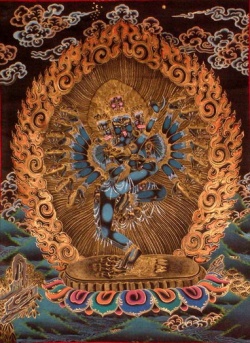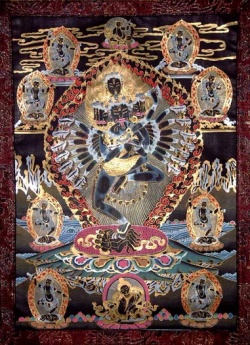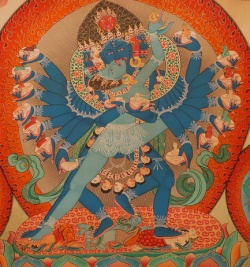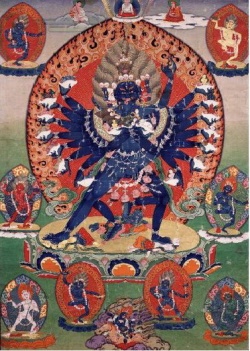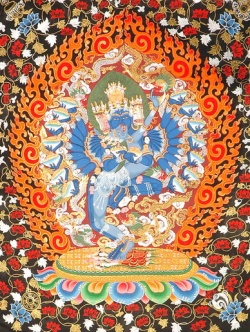A Safe Guide for the Practitioner of Hevajra Tantra
I. Preparation
On page 116 of the Hevajra Tantra (The Hevajra Tantra, published by the Oxford University Press) to which we will be referring throughout this booklet, it is written:
"The Lord replied: irst there should be the public confession, then they should be taught the ten rules of Virtuous Conduct, then the Vaibhasya teachings and then the Sautrantika, after that the Yogacara and then the Mayamika. Then when they know all mantra-methods, they should start upon Hevajra. The pupil who lays hold with zeal should succeed, there is no doubt.?
The guide says: This is proof for my emphasis on the ThreeYanas-in-One that he who is not well accomplished in the Hinayana meditation of purification and in the Mahayana meditation of sublimation should not practice the Vajrayana meditation either of Hevajra or of any other Heruka. An Indian proverb runs: "The dog who follows the lion to jump off a rocky hill will lose its life."
II. Master Consecration
On page 59 is written:
"Imagine that from the seed in your own heart you lead forth a ray, which is shining black in color and of the form of a hook, and by means of this you draw in the Buddhas who are stationed throughout the threefold world. Having worshipped them with the eight goddesses, you should beseech them saying: M may all the Buddhas consecrate me.?Then you will be consecrated by those Buddhas who have all assumed the form of Heruka, with the five vessels which symbolize the Five Tathagatas and which contain the five ambrosias. At the time of consecration there will be a shower of flowers and one of saffron; drums will sound; you will be worshipped by Rupavajra and her companions, and Locana and the others will sing vajra-songs. When you have been thus consecrated, the Lord of your Family will appear on your head, and Heruka will be revealed in you."
The guide says: This is a common first consecration (initiation) which may be held by a Guru or by yourself. However, this Tantra lays more stress on the Third Consecration (initiation) practice. All four Consecrations may be held in the sense of the third consecration, as on page 96:
"The Prajna of sixteen years he clasps within his arms, and from the union of the vajra and bell, the Master consecration comes about."
For the neophyte, the first time this master consecration is held must be under the guidance of a personal Guru. Nowadays it is very easy for the Westerners to get a Guru in Sikkim, Kalimpong or Darjeeling where many Tibetan lamas have become refugees. Without a Guru, one will have no real connection with the first consecration even if he has read the book many times.
After this master consecration has been given by a Guru, you will receive a concise ritual according to which you should practice the repetition of this Hevajra Tantra, as mentioned in III below.
III. Visualization and Repetition
A. Visualization on the Hevajra
On page 110 is written:
- "I have eight faces, four legs, and sixteen arms, and trample the four Maras under foot. Fearful am I to fear itself, with my necklace made of a string of heads, and dancing furiously on a solar disk; Black am I and terrible with a crossed Vajra on my head; My body smeared with ashes, and my mouth sending forth the sound HUM. But my inner nature is tranquil, and holding Nairatmya in loving embrace, I am possessed of tranquil bliss. My front face is black, the one to the right is like white jasmine, the one to the left is red and fearful and the one to the rear is distorted. The remaining faces are like those of bees, and there are twenty-four eyes and so on."
B. Visualization on the Mandala
On page 82:
- The Mandala is "blazing and brilliant, square with four portals, adorned with garlands and chains and variously colored streamers, equipped with eight columns and vajra-threads, decorated with flowers of different hues, with incense, lamps, and scents, and provided with the eight vessels. These last have branches in them, and their necks are covered with cloth and encircled with the five kinds of gems. To the East one should place the Vessels of Victory. With a fair new thread, well fastened and of right measurement, the master should bind it round, for it represents the chosen divinity."
C. Visualization on Nairatmya
On page 116 it is written:
- "She is neither too tall, nor too short, neither quite black nor quite white, but dark like a lotus-leaf. Her breath is sweet, and her sweat has a pleasant smell like that of musk. Her pudenda gives forth a scent from moment to moment like different kinds of lotuses or like sweet aloe wood. She is calm and resolute, pleasant in speech and altogether delightful, with beauteous hair and three wrinkles in the middle of her body. By vulgar men, in fact, she would be classed as first rank."
Further on page 75 it is said:
- "The knife (held in her right hand) is there to cut off the six defects and pride and so on, and the skull (held in her left hand) for bringing to an end discriminating thought which would regard existence and non-existence as essentially different. From it one drinks the blood of the Four Maras."
D. Visualization on Mandala of Nairatmya
On page 73 it is written:
- "Concentrate upon the triangle of origination in the midst of space, and then perform this meditation at its center, first the figurative representations of the four elements in their right ordern the due order of appearance of the divinities. The mandala which now arises pure and unblemished from the triangle, consists of two concentric parts, one formed by the eight central petals of the lotus, and the other triangle. At the center one should image a corpse, which is in effect the seat of the fifteen yoginis. Resting on that there should be a lunar disk, upon that the seed-syllable and upon that a solar disk. The conjunction of these two, lunar disk and solar disk, is the great bliss. All has become the moon, and the sun has resolved into Kali, and from this mingling of sun and moon Gauri and her companions are proclaimed to be."
E. Repetition
On page 82 it is said:
On page 50 the Mantra of the heart of Hevajra:
- "OM DEVA PICU VAJRA HUM HUM HUM PHAT SVAHA" has been given.
IV. Evolutional Yoga (Utpattikrama)
The guide says: Besides the above mentioned practices, nothing in the book describes the Evolutional Yoga. The practitioner should ask his personal Guru to impart it with the elaborative commentary of the Hevajra Tantra. Unless and until you have accomplished this Evolutional Yoga, that is to say, your body and speech and mind have been made entirely like the Hevajra, you should not practice the following practice.
V. Secret Consecration
On page 96 it is written:
"She is fair-featured, wide-eyed, and endowed with youth and beauty. Then with thumb and fourth finger he drops the bindu in the pupil mouth."
VI. Perfect Yoga (Utpannakrama), Part I
The guide says: After this second Consecration is performed, the following is the main practice different from the above. The wisdom nerves should be visualized through which the deep wisdom breathing should be seen as going in and out and held; and the wisdom drops should be seen as going up and down and kept without any discharge. There are many methods to do this which are not available in this book. The practitioner is advised to get all of the instructions from a personal Guru. In the book there are only a few lines on the Perfect Yoga quoted below:
On page 49 it is written:
"There are thirty-two veins that bear Bodhicitta, and flow into the place of great bliss. Among these three veins are the chief, Lalana, Rasana, and Avadhuti. Lalana has the nature of Wisdom and Rasana consists, in the means of the Expedience, and Avadhuti in the middle, free from the notion of subject and object."
On page 94 it is written:
"The sacred syllable E, adorned at its center by the syllable VAM, is the abode of all delights, the casket of Buddha-gems. It is there that the four Joys arises, distinguished by the Moments, and from knowledge of these Moments the knowledge of Bliss is consummated in that sound EVAM. So yoginis know that the sound EVAM is attainable through the four Moments."
The guide adds: This EVAM is practiced with both the visualized yogini in this yoga or the real yogini in the sense of the Third Consecration as below.
VII. Prajna Consecration (Perfect Yoga, Part II)
On page 96 it is written:
"In that very act the flavor of sameness should be placed within the pupil range. Then having honored and worshipped the Prajna (the Yogini), he should consign her to the pupil saying: Great Being, take thou the Mudra who will bring you bliss,?and knowing his pupil to be worthy, free of envy and wrath, he then further commands him: e ye one, O Vajradhrk.?
VIII. Philosophic Background Should be Recognized
A. To Know what is meant by Heruka.
On page 72 it is written:
" "SRI implies monistic knowledge, HE the voidness of causality, RU the end of discriminating thought, KA its indeterminability."
B.
On page 97 it is written:
" "You should slay living-beings. You should speak lying words. You should take what is not given. You should frequent others?wives."
Now to practice singleness of thought is the taking of life, for the thought is the life. To vow to save all men is interpreted as lying-speech. That what is not given is the bliss of woman, and she is your own Nairatmya who is the wife of all others."
C. To Know the Five Elements are in the One Essential Unity
On page 93 it is written:
- "From the contact that comes of the union of Vajra and Lotus, there arises the effect of hardness. The nature of hardness is delusion, and Vairocana is deemed to be delusion. The Bodhicitta is a flow and this flow is deemed as water. The nature of water is wrath and this wrath is Aksobhya. From the rubbing together of two things fire always arises. From heat arises passion and this passion is Amitabha. The Bodhicitta in the lotus has the nature of air. From air arises envy, and envy is Amoghasiddhi. The blood is bliss and passion and the nature of bliss is space. From space arises malignity and malignity is Ratnasambhava. Yet they all arise from the one clan of perfect joy."
D. To Know all the Reasons and Parables for Vajra-Love Practice
On page 93 it states:
- "With the very poison, a little of which would kill any other being, a man who understands poison would dispel another poison. Just as a man who suffers with flatulence is given beans to eat, so that wind may overcome wind in the way of a homeopathic cure, so existence is purified by existence in the countering of discursive thought by its own kind. Just as water entered in the ear is drawn out again by water, so also the notion of existing things is purified by appearances. Just as those who have been burned by fire must suffer again by fire, so those who have been burned by the fire of passion must suffer the fire of passion. Those things by which men of evil conduct are bound, others turn into means and gain thereby release from the bonds of existence. By passion the world is bound, by passion too it is released, but by the heretical Buddhists this practice of reversals is not know."
IX. To Know All the Conditions of Vajra-Love Practice
A. The sign of the yogin and the yogini
On page 118 it is written:
- "Whatever man or woman has a nine-pointed vajra on the lower joint of the fourth finger, belongs to Aksobhya family, which is the highest. For Vairocana there would be a wheel, for Amitabha a lotus, for Ratnasarnbhava a gem and for Amoghasiddhi a sword."
B. The good place for this practice
On page 81 it states:
- "In a garden or in a lonely spot or in a Bodhisattva house or in the center of the mandala-hall (Temple in which the rite is performed.)"
C. The auspicious time for this practice
On page 71 it is written:
- "The fourteenth and the eighth days in the dark fortnight."
The guide explains: In the Tibetan system, one month is divided into two parts, the bright half is from the first to fifteenth days while the dark half here means from the sixteenth to the thirtieth days. Therefore the eighth day in the dark half means the twenty-third day of the month and the fourteenth means the twenty-ninth, if we are counting days from the beginning of the new month.
X. To Get the Practical Methods and Experiences from a Personal Guru
A. Methods.
- The guide says: "How to choose certain postures for certain Dakini or Yogini? How to find out the secret and sacred Sukha-nerve in the Lotus? How to make the sukha-nerve prolonged? How to drink the great bliss nectar from the Lotus by the Vajra? These and many other methods are not all described in this Hevajra Tantra. You must ask your Guru for them."
B. Experiences:
(1) Experiences in the Four Joys and their four moments
On page 76 it states:
- "From Joy there is some bliss, from Perfect Joy yet more, From the Joy of Cessation comes a passionless state. The Joy of the Innate is finality. The first comes by desire for contact, the second by desire for bliss, the third from the passing of passion, and by this means the fourth is realized. Perfect Joy may be called Samsara, and Nirvana, the Joy of Cessation, with plain Joy as a middle state. But the Innate is free of all three; for there is found neither passion nor absence of passion, nor yet middle state."
On page 95 it is written:
- "The first Joy is found in variety, Perfect Joy in Development, the Joy of Cessation in Consummation and the Joy of the Innate in Blank."
(2) Experiences in the Four Voidness
- The guide says: There are four voidness which should be identified with the four joys. But in the book they are neglected. Nevertheless, the Principle of Voidness in general is taught a great deal in the book as quoted below:
On page 83 is written:
- "Nothing is mentally produced in the highest bliss, and no one produces it. There is no bodily form, neither object nor subject, neither flesh nor blood, neither dung nor urine, no sickness, no delusion, no purification, no passion, no wrath, no envy, no malignity, no conceit of self, no visible object, nothing mentally produced and no producer, no friend is there, no enemy, calm is the Innate and undifferentiated."
(3) Experience in realization
On page 82 it is written:
- "At first it appears as cloud, but with realization arisen it appears as maya; then it suddenly appears as sleep with no distinction between sleep and the waking state. The yogin of the Great Symbol gains fulfillment in that which is no fulfillment, for its characteristic is the very absence of any characteristic."
XI. Fourth Consecration (Perfect Yoga, Part III)
On page 96 it states:
"When the pupil has now reached the moment of Perfect Joy which is free from all notions of diversity the master should say: Great Being, hold thou to the great bliss. Until the time of enlightenment, O Vajradhrk, serve thou the cause of beings.?Thus should speak the Adamantine Lord as he sees his pupil overwhelmed in compassion. This is the great knowledge that exists in all phenomenal forms, dual by nature and yet free of duality, the Lord whose essence is both existence and non-existence. He abides pervading all things, moving or motionless, for he manifests himself in these illusive forms."
On page 91 it is written again:
"So in truth there is neither destruction nor origination. Having dissolved away, it has come to its end, and since there can now be no dissolution, neither is there destruction. The yogin conceives of the diversity of existence as the Process of Emanation, and realizing the dream-like nature of this diversity, he renders it undiversified by means of its diversity. Like a dream, like a mirage, like the "intermediate state," so the Mandala appears from continuous application to the practice. The great bliss, such as one knows it in the consecrations of the Great Symbol (that is to say the fourth consecration) of that Mandala is the full and efficacious expression, for nowhere else does it have its origin. This bliss is black and yellow, red and white, dark green, dark blue, all things moving or unmoving. This bliss is Wisdom, this bliss is Means (expedience), and likewise it is their union. It is existence, it is non-existence and it is Vajrasattva."
XII The Summary of the Guide
The guide says: Among all the English Buddhist writers there are three kinds of opinions on the Third Consecration practice. The first opinion is of those conservatives who advocate that Tantric Doctrines should be kept secret. Some of them even dare to lie saying that there is no such thing as vajra-love in Buddhism. Although he may call himself a Lama and actually lives with his wife, for the commercial purpose of the publisher, in his written work he purposely talks of the second consecration practice of vajra-love within one body as the third one without the body. He may fool some of the readers some of the time, but he cannot fool all the readers all the time. As in our age every religion must show its ultimate truth and essential methods to others for a comparative study, so there is no religion which can any longer keep its doctrines in secret. You may do this yourself if you like, but you cannot forbid everyone else to open the door widely to others. Suppose a couple of young lovers wish to keep their love in secret, as the thief in the night, but when she has conceived and has a big belly, when she is rearing the baby and feeding it with bare breasts, when the child is three years old and walks in the street joining hands with his parents, their love can in no way be hidden any longer. This is like it is in our age. What a nice thing it would be if we lived back in ancient times!
The second kind of opinion is of those radicals who are earnest in researching the doctrines of Vajra-Love and ambitious to introduce and translate it for the West, but care little about the ancient rules or about the reactions of different modern readers. I disagree with this opinion, too.
The third kind is like mine, that of the eclectics. When there are some secret doctrines that have not yet been breathed a word about, I also continue to keep silent about them. But when a doctrine is already coming to readers?ears, I would like to offer them safe guidance in order to guard them against falling. Hence my duty is this: To show the whole system as a path and its different stations. To point out the snake in the grass if any danger will be caused by wrong practice. To explain all the conditions of safety. To determine the whole course of practice and emphasize proper preparation. This booklet has been written under all these principles. It may seem I have asked you to do more with theory than with practice. If you are excited by your deep interest, you cannot help learn it. There is another way instead of the Tantric method which you may practice without a Guru which is the way of the Pure Land School. If you can hang up a picture of Hevajra upon your wall and that of the Mandala below it, you may worship them, repeat the incantation of Hevajra for one hundred thousand times, and ask Him to help you to get all the conditions of renunciation and to meet a personal Guru of this kind under whom you may then start to practice the Tantric way. As soon as you get a Guru, my duty of safe guide is then integrated and accomplished.

